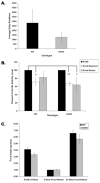Nhlh2: a basic helix-loop-helix transcription factor controlling physical activity
- PMID: 18815487
- PMCID: PMC2707263
- DOI: 10.1097/JES.0b013e31818782dd
Nhlh2: a basic helix-loop-helix transcription factor controlling physical activity
Abstract
In mice, targeted deletion of the basic helix-loop-helix transcription factor, nescient helix-loop-helix 2 (Nhlh2), leads to adult-onset obesity and reduced physical activity. We propose the novel hypothesis that transcriptional activity by Nhlh2 (NHLH2 in humans) controls either the ability or the motivation for exercise.
Figures




References
-
- Barth AS, Kuner R, Buness A, Ruschhaupt M, Merk S, Zwermann L, Kaab S, Kreuzer E, Steinbeck G, Mansmann U, Poustka A, Nabauer M, Sultmann H. Identification of a common gene expression signature in dilated cardiomyopathy across independent microarray studies. J. Am. Coll. Cardiol. 2006;48:1610–1617. - PubMed
-
- Cai G, Cole SA, Butte N, Bacino C, Diego V, Tan K, Goring HH, O'Rahilly S, Farooqi IS, Comuzzie AG. A quantitative trait locus on chromosome 18q for physical activity and dietary intake in Hispanic children. Obesity (Silver Spring) 2006;14:1596–1604. - PubMed
-
- Coyle CA, Jing E, Hosmer T, Powers JB, Wade G, Good DJ. Reduced voluntary activity precedes adult-onset obesity in Nhlh2 knockout mice. Physiol. Behav. 2002;77:387–402. - PubMed
-
- Farooqi S, O'Rahilly S. Genetics of obesity in humans. Endocr. Rev. 2006;27:710–718. - PubMed
-
- Fox DL, Vella KR, Good DJ. Energy balance pathways converging on the Nhlh2 transcription factor. Front Biosci. 2007;12:3983–3993. - PubMed
Publication types
MeSH terms
Substances
Grants and funding
LinkOut - more resources
Full Text Sources
Molecular Biology Databases

